Matthew Warke*, Gloyne Research Fund winner, investigates the Palaeoproterozoic rise in oxygen on the Kaapvaal Craton.
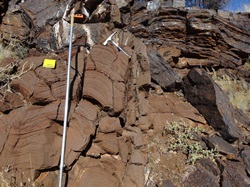 The first half of the Palaeoproterozoic (c. 2.5 – 2.0Ga) was a period of extensive environmental change on Earth. Arguably the most significant change during that period was the irreversible establishment of an oxidised atmosphere and hydrosphere between 2.45 and 2.32 billion years ago, the period known as the ‘Great Oxidation Event’ (GOE), during which atmospheric oxygen concentrations rose above 10-5 PAL (Present Atmospheric Level) for the first time.
The first half of the Palaeoproterozoic (c. 2.5 – 2.0Ga) was a period of extensive environmental change on Earth. Arguably the most significant change during that period was the irreversible establishment of an oxidised atmosphere and hydrosphere between 2.45 and 2.32 billion years ago, the period known as the ‘Great Oxidation Event’ (GOE), during which atmospheric oxygen concentrations rose above 10-5 PAL (Present Atmospheric Level) for the first time.
Picture: Stromatolitic bioherms on the farm Taaibosfontein attaining a maximum thickness of approx. 2 m.
The rise was sufficient to cause a significant change in the geochemical cycling of sulphur in Earth’s fluid envelopes and thus produce a distinct geochemical signal that indicates an oxidising atmosphere1. This signal has been used to trace the onset of the GOE in Palaeoproterozoic units across North America, Fennoscandia, Western Australia and southern Africa.
There is still much we don’t know about the GOE. Aerobically photosynthesising cyanobacteria evolved and were producing oxygen sometime prior to 2.65Ga2. Oxygen started to accumulate in depositional environments when the cyanobacterial organic matter was rapidly buried; this permitted the oxygen produced in photosynthesis to escape back-reaction to carbon dioxide through respiration. Why, then, did it take approximately 200-300 million years to establish an oxidised atmosphere? Various biological and tectonic hypotheses have emerged to address this question, each discussing either the sources of oxygen (e.g. the evolution of photosynthesis in cyanobacteria) or potential physical and chemical sinks of free oxygen3.
New data
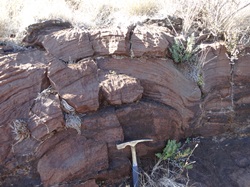 Picture: Stromatolitic bioherms on the farm Taaibosfontein.
Picture: Stromatolitic bioherms on the farm Taaibosfontein.
In order to best evaluate these hypotheses there is a need for new geochemical data from successions deposited prior to the GOE. Such data may elucidate the processes in operation between the evolution of aerobic photosynthesis and the GOE. However, it is highly important that such data are collected within the context of petrological and geochemical data that explore the diagenetic and/or metamorphic processes that may have affected the geochemistry of the rock post-depositionally, and thus altered any primary oxygenation signal. It is also crucial that we examine the sedimentology of these rocks so that we can better understand the evolution of the basins and depositional environments in which they were deposited.
My PhD research focuses on three South African successions deposited on the Kaapvaal Craton (South Africa) in the early Palaeoproterozoic. Of these successions, the Tongwane and lower Duitschland formations in the Transvaal basin, and the Koegas Subgroup in the Griqualand West basin, were deposited prior to the GOE, whereas the upper Duitschland Formation (Transvaal basin) postdates it.
Our aim is to understand how oxygen began to build up in depositional environments on the Kaapvaal Craton before the GOE. We aim to contribute new sections, new geochemical datasets and, where possible, new geochronological constraints on the Transvaal Supergroup that may assist in future attempts at regional and global stratigraphic correlation. We also aim to produce new (or refined) depositional and diagenetic models of these successions.
Koegas Subgroup
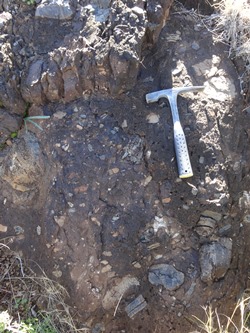 Picture: Unstratified and massive Makganyene Diamictite with large chert clasts of mixed sphericities.
Picture: Unstratified and massive Makganyene Diamictite with large chert clasts of mixed sphericities.
With these aims in mind I set off for my second field season in South Africa in late May 2014. I was to spend just over three weeks in the field studying the Koegas Subgroup and the overlying Makganyene Diamictite in Northern Cape Province before returning to Johannesburg in June to begin two weeks of geochemical work in the labs at the University of Johannesburg (UJ).
For the first four days of my excursion I was accompanied by Professor Nic Beukes (UJ), and a field assistant, UJ MSc student Conrad de Kock. Nic led us on a comprehensive tour of the Koegas and Makganyene as exposed around the quiet settlements of Prieska and Griquatown. This eerily beautiful - and very rural - part of Afrikaans-speaking South Africa is dry and dusty, its strikingly bright orange soils derived from windblown Kalahari sands.
The Koegas Subgroup is composed of seven formations4 ranging in composition from iron-formation to sandstones, siltstones, mudstones, and minor carbonates in the form of ‘stromatolitic bioherms’. Stromatolitic bioherms form a prominent marker bed which we (by - carefully - picking our way through swarthaak (‘black-hook’) bushes) traced and mapped for just over two kilometres across the Taaibosfontein farm. Sections of the Koegas were logged here and on neighbouring farms and samples gathered for petrographic and geochemical analysis in Manchester.
Makganyene Diamictite
The contact between the Makganyene Diamictite and the underlying Koegas Subgroup is also exposed on Taaibosfontein. The Makganyene Diamictite is a world-renowned glacial deposit and has been argued as evidence for a Palaeoproterozoic ‘Snowball Earth’ episode5. Established stratigraphic models place a significant 150myr hiatus between the deposition of the Koegas and the Makganyene. However, some workers have argued that “lenses” of Makganyene reported from within the lower Koegas show that the two units are coeval, lateral equivalents6.
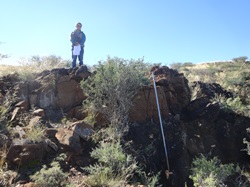 Picture: Standing atop a brecciated carbonate “raft”. Makganyene Diamictite overlies, and underlies, the brecciated carbonate.
Picture: Standing atop a brecciated carbonate “raft”. Makganyene Diamictite overlies, and underlies, the brecciated carbonate.
This would imply that the Makganyene Diamictite was deposited immediately prior to the GOE and not c.100 million years afterwards, as is widely thought. If correct this ‘older Makganyene’ scenario would have serious ramifications for any ‘cause and effect’ relationship between the GOE and a Palaeoproterozoic Snowball Earth.
However this is extremely doubtful. Across the Northern Cape the glacial unconformity at the base of the Makganyene cuts down into the Koegas at several stratigraphic levels7 and striated pavements are visible beneath the diamictite on Taaibosfontein. On the isolated farm Klooffontein, north of Prieska, Nic and I debated a puzzling outcrop of carbonates and diamictite. While Nic envisages the diamictite draping an upper Koegas karst surface, it seems more likely that the carbonates - which are heavily brecciated, discontinuous, and are overlain and underlain by diamictite - are isolated blocks of Koegas carbonate (several metres wide) which have been entrained into the diamictite.
In either case our field evidence seems to indicate that the carbonates became lithified prior to glacial erosion. Thus we do not consider the Koegas and Makganyene to be coeval, though our evidence is limited and we are unable to quantify the length of the hiatus between the deposition of the Koegas and the Makganyene. Thus we cannot rule out the possibility that the Makganyene may be significantly older than currently thought, and may correlate with a postulated ‘cryptic glacial horizon’ within the Duitschland Formation8; this horizon also marks the onset of the GOE as recorded in South Africa.
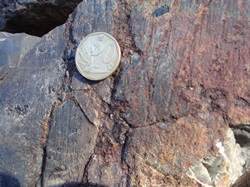 Picture: Striated pavement beneath the Makganyene Diamictite on the farm Taaibosfontein.
Picture: Striated pavement beneath the Makganyene Diamictite on the farm Taaibosfontein.
So, what are these “lenses” of Makganyene? Given their reported stratigraphic position within the Koegas they are likely to be exposures of a conglomerate member that occurs at the base of the Doradale Iron Formation (Koegas Subgroup). The Makganyene and basal Doradale conglomerate are superficially similar, both being matrix-supported, massive units with chert and carbonate clasts ranging widely in size and sphericity; they also have a similar weathering profile.
However, unlike the Makganyene, the Doradale conglomerate (as seen on Pannetjie farm just outside Griquatown) is not laterally persistent. It is lenticular in nature and often only exposed for 1-10m before thinning laterally into low-energy iron formation; it may represent higher-energy channelised deposits within the iron formation.
Summary
As our petrological and geochemical analysis continues, we expect that our samples from the Koegas Subgroup will prove useful in understanding both the rise in oxygen on the Kaapvaal Craton (prior to the GOE) and the diagenesis of the Koegas succession. Our field observations have helped to address some of the sedimentological and stratigraphic problems that persist in Griqualand West, but there remain many unaddressed stratigraphic problems (such as a lack of absolute age data and robust stratigraphic correlations) which will limit our understanding of how oxygen may have arisen in these environments.
Picture: Farm Taaibosfontein
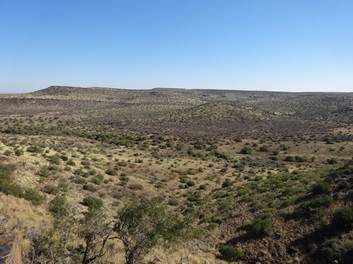 Acknowledgements
Acknowledgements
I would like to thank the Geological Society for financial support through the Gloyne Outdoor Research fund. I would also like to thank N. Beukes, C. Vorster, and C. de Kock for field, laboratory and/or logistical support and the staff of the Geology Dept., University of Johannesburg for their hospitality.
*Matthew Warke is at Manchester University E: [email protected]. For more information on the Society’s fieldwork research funds, please go to ‘Awards, Grants & Bursaries’.
References
- FARQUHAR, J., BAO, H. and THIEMENS, M. 2000. Atmospheric Influence of Earth’s Earliest Sulfur Cycle. Science, 289, 756-758.
- ANBAR, A.D., DUAN, Y., LYONS, T.W., ARNOLD, G.L., KENDALL, B. CREASER, R.A., KAUFMAN, A.J., GORDON, G.W., SCOTT, C., GARVIN, J. and BUICK, R. 2007. A Whiff of Oxygen Before the Great Oxidation Event? Science, 317, 1903-1906.
- KASTING, J.F., PAVLOV, A.A. and SIEFERT, J.L. 2001. A coupled ecosystem-climate model for predicting the methane concentration in the Archean atmosphere. Origins of Life and Evolution of the Biosphere, 31, 271-285
- SCHRÖDER, S, BEDORF, D., BEUKES, N.J. and GUTZMER, J. 2011. From BIF to red beds: Sedimentology and sequence stratigraphy of the Paleoproterozoic Koegas Subgroup (South Africa). Sedimentary Geology, 236, 25-44.
- EVANS, D.A., BEUKES, N.J. and KIRSCHVINK, J.L. 1997. Low-latitude glaciation in the Palaeoproterozoic era. Nature, 386, 262-266.
- POLTEAU, S. 2000. Stratigraphy and geochemistry of the Makganyene Formation, Transvaal Supergroup, Northern Cape, South Africa. M.Sc thesis (unpublished), Rhodes University, 154 pp.
- ALTERMANN, W. and HÄLBICK, I.W. 1990. Thrusting, folding and stratigraphy of the Ghaap Group along the southwestern margin of the Kaapvaal Craton. South African Journal of Geology, 93, 553-566.
- HOFFMAN, P.F. 2013. The Great Oxidation and a Siderian snowball Earth: MIF-S based correlation of Paleoproterozoic glacial epochs. Chemical Geology, 362, 143-156.